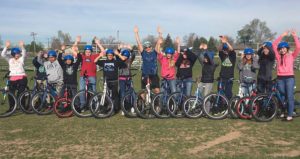Giving students opportunities to stay active during the school day benefits them physically, academically, socially, and emotionally.
Students wearing the IHT ZONE wrist heart rate monitor receive immediate feedback that motivates them to maximize those opportunities. With the IHT ZONE, students and teachers can:
- See real-time heart rate feedback,
- Correlate the heart rate zone color display to feelings in an emotional self-regulation program,
- Create assessments that track progress toward physical and social guidelines, and
- Receive email summaries detailing heart rate and progress toward a teacher’s goal.
Motivated by Real-Time Feedback
Students see more than their actual heart rate when wearing the IHT ZONE. Along with the number, they see a color that shows their exertion level. The monitor turns blue when students get started or are resting. It turns yellow as the student’s heart rate starts to rise. When the monitor turns red, the student’s heart is working extremely hard – a sign of a vigorous workout.
 The feedback is student-specific, so each student only needs to check their own monitor to see how hard they are working. Teachers set a goal for students to spend a specific amount of time in the yellow or red zones. Students then push themselves to meet that goal.
The feedback is student-specific, so each student only needs to check their own monitor to see how hard they are working. Teachers set a goal for students to spend a specific amount of time in the yellow or red zones. Students then push themselves to meet that goal.
“The kids are understanding,” Fort Lupton Middle School (Colo.) health teacher Lindsay Yost said. “They want to see it get into the yellow zone. They want to work much harder.”
Managing Stress in an Emotional Self-Regulation Program
The colors also correspond to emotions. Students at East Elementary School (Littleton, Colo.) wear the ZONE heart rate monitors in a program that teaches students to manage their emotions. NBC’s Today Show featured the program.
In Operation Dragon Heart, students wear the ZONE monitor throughout the day. They correspond the colors to what they are feeling. Blue means calm or happiness; yellow indicates excitement or nervousness; red indicates anger, fear or anxiety.
“The vision is to link children with regulating their emotions, being able to physically see what’s happening in their body,” counselor Kim Bailey said. “Then they can associate that with the feeling and they are able to use the techniques we’re using to help calm themselves down.”
Students improved their ability to manage their emotions and behaviors by controlling their heart rate.
“I was really emotional and now I’m a little bit stronger and calmer,” said second-grader Charlotte Sherwood. “I feel it’s made a big difference since I started wearing the monitor.”
Delivering Information That Students, Families Can Understand
Beyond the real-time feedback, students – and parents – receive a post-session email that analyzes the just-completed workout. As soon as students return the monitor, the software delivers a recap email. The recap includes several key details:
- A graph of the student’s heart rate while exercising,
- Total time spent exercising, including time spent in each heart rate zone, and
- How the student performed to that day’s class goal.
The reports allow students to have detailed conversations with parents or teachers.
“It’s just a huge level of awareness, and instead of just talking about it, they can actually see what’s going on,” Mason City High School (Iowa) PE teacher Andi Ludwig said. “As they start to pay attention to what’s happening [on their report], I can ask and they say, ‘oh, that’s when I was doing jumping jacks or the running circuit.’’
Students benefit from immediate feedback. Parents enjoy seeing what their children accomplished in a class that previously had few opportunities to share objective data.
“What’s the old quote?” Portage Central Middle School PE Coordinator John Dunlop said. “‘Without data, you’re just another person with an opinion.’ To have to share with the kids and parents and to use it as a teacher, this is something that is very beneficial.”
Assessing Students Across PE and SEL Measures
At Lesher Middle School (Fort Collins, Colo.), students focus on their physical and emotional health during their PE classes. Teachers Matt Moeller and Jo Dixon emphasize behavioral skills in a movement-based program designed to develop well-rounded, healthy students.
“We want to promote heart health,” Dixon said. “That is our number one priority because the heart is the most important muscle in your body. We want the students to understand what that feels and looks like. The ZONE allows us to really focus on teaching about heart health. We have all this information and we share it all with the students.”
Just as importantly, however, Moeller and Dixon teach students how to interact with each other.
“Are students hitting their target heart rate? Are students able to shake hands with others and introduce themselves? Can you be a good teammate and learn what spirit of the game means?” Dixon explained. “Those components are lifelong.”


